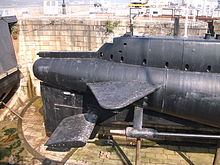Diving plane

Diving planes, also known as hydroplanes, are control surfaces found on a submarine which allow the vessel to pitch its bow and stern up or down to assist in the process of submerging or surfacing the boat, as well as controlling depth when submerged.[1]
Bow and stern planes

Diving planes are usually fitted in two pairs, the bow planes at the front of the submarine and the stern planes at the rear. The stern planes function in much the same way as an aircraft's elevator. As the planes are a long distance fore-and-aft from the hull's centre of buoyancy, they introduce a pitching moment. Ballast tanks within the submarine adjust buoyancy to be neutral, making the boat controllable. The position of the planes controls the pitch of the boat and, with the forward motion of the boat, this controls depth. If not carefully controlled, this could lead to a 'porpoising' motion whereby the planesman continually hunts for a stable combination of depth and pitch.[2]
For easier berthing close alongside a jetty, submarines have used folding bow planes that retracted alongside the hull. Earlier submarines (to World War II) used vertical folding planes perpendicular to their surface. US submarines referred to this stowage as 'rigging' the planes, and 'tilting' for their control movement.[3] Later Soviet submarines have tended to fold backwards, into recesses in the casing.

Fairwater planes

Simon Lake of the Lake Torpedo Boat Company[2] was the first to develop planes that could control depth without introducing a pitching moment. Stern planes and rudder were mounted below the stern akin to a conventional ship. The depth control planes were mounted on the beam, so that they acted vertically, without the lever arm to introduce the usual pitch.[2]
Diving planes located on the sail (conning tower) are called fairwater planes on US Navy submarines.[4] Fairwater planes do not pitch the ship up or down; they cause the boat to rise or sink on a level plane as they are operated.

When operating beneath polar ice, a submarine with planes on the sail must break them through the ice when surfacing. From the Sturgeon class they were arranged to be able to be pointed vertically upwards, rather than being rigged or folded in.[4]
Newer boats, starting with the third-flight Los Angeles class subs (or 688is) have eliminated the sail planes, and operate instead with bow planes.
Controls

From the outset, diving planes were controlled remotely by telemotors, early servomechanisms operated electrically or by hydraulics.
Maintaining depth in a submarine is a sophisticated task. The planesman was provided with a prominent depth gauge to monitor this, usually a circular Bourdon gauge. For precise maintenance at periscope depth an additional shallow-depth manometer, a transparent vertical pipe, would be provided too. With the development of active sonar, depth control became even more complex. Rather than maintaining a simple depth, the planesman must now keep the boat beneath a thermocline in order to hide from sonar. To this end, the helm position may also show external water thermometers and salinometers.

Early submarines had separate controls for each pair of planes, bow and stern. Together with the helmsman, this required three ratings in the already-crowded control room. By the 1960s, combined controls were introduced. These incorporated all planes onto a single aircraft-style control wheel.
Cars
In automotive terms, dive planes (which physically resemble submarine diving planes) are aerodynamic devices fitted on cars just ahead of the front wheels. They are most commonly found on racing cars such as the Le Mans Prototype Series and are used to create additional downforce and channel airflow to help balance the car. The 2012 Mercedes-Benz C63 AMG Black Series is one of the first road cars to feature these devices.[5]
References
- ^ Bureau of Naval Personnel (June 1946). Bow and Stern Plane Systems. pp. 105–130.
{{cite book}}:|work=ignored (help) - ^ a b c Christley, Jim (2011). US Submarines 1900–1935. Osprey Publishing. p. 25. ISBN 978-1-84908-185-6.
- ^ Fleet Submarine, p. 115
- ^ a b Friedman, Norman (1994). U.S. Submarines Since 1945: An Illustrated Design History. Annapolis, Maryland: United States Naval Institute. pp. 144–149, 243. ISBN 1-55750-260-9.
- ^ "2012 Mercedes-Benz C63 AMG Black Series - First Drive". Road & Track. 10 February 2012. Archived from the original on 13 February 2012. Retrieved 10 February 2012.
